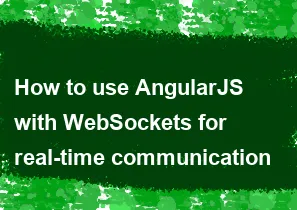How to use AngularJS with WebSockets for real-time communication

To use AngularJS with WebSockets for real-time communication, you'll need to set up a WebSocket server on the backend and integrate it with your AngularJS frontend. Here's a general guide on how to achieve this:
Set up a WebSocket server: You can use various technologies for this such as Node.js with libraries like Socket.io or ws, Python with libraries like WebSocket or Tornado, Java with libraries like Java-WebSocket, etc. Choose the technology that best fits your backend stack and set up a WebSocket server.
Integrate WebSocket server with AngularJS: In your AngularJS application, you'll need to establish a WebSocket connection to the server. You can use the built-in WebSocket API in JavaScript for this purpose. Typically, you'll create a service in AngularJS to manage the WebSocket connection.
javascriptangular.module('myApp').service('WebSocketService', function() { var socket = new WebSocket('ws://localhost:3000'); // Replace with your WebSocket server URL this.send = function(message) { socket.send(message); }; this.onMessage = function(callback) { socket.onmessage = function(event) { callback(event.data); }; }; this.close = function() { socket.close(); }; });Use WebSocketService in your AngularJS controllers/directives: Inject the
WebSocketServiceinto your controllers or directives where you want to handle WebSocket communication. You can send messages to the server, receive messages from the server, and perform any necessary actions based on the received data.javascriptangular.module('myApp').controller('MyController', function($scope, WebSocketService) { $scope.sendMessage = function() { WebSocketService.send('Hello from AngularJS!'); }; WebSocketService.onMessage(function(message) { $scope.$apply(function() { $scope.receivedMessage = message; }); }); });Handle WebSocket messages on the server: On the server-side, you'll need to handle WebSocket messages and broadcast them to other connected clients as needed. This part depends on the technology you chose for your backend.
Error handling and closing WebSocket connection: Make sure to handle errors and close the WebSocket connection properly in your AngularJS application.
That's a basic overview of how to use AngularJS with WebSockets for real-time communication. Remember to handle security considerations such as authentication and authorization, as well as scalability issues when designing your real-time application.
-
Popular Post
- How to optimize for Google's About This Result feature for local businesses
- How to implement multi-language support in an Express.js application
- How to handle and optimize for changes in mobile search behavior
- How to handle CORS in a Node.js application
- How to use Vue.js with a UI framework (e.g., Vuetify, Element UI)
- How to configure Laravel Telescope for monitoring and profiling API requests
- How to create a command-line tool using the Commander.js library in Node.js
- How to implement code splitting in a React.js application
- How to use the AWS SDK for Node.js to interact with various AWS services
- How to use the Node.js Stream API for efficient data processing
- How to implement a cookie parser middleware in Node.js
- How to implement WebSockets for real-time communication in React
-
Latest Post
- How to implement a dynamic form with dynamic field styling based on user input in Next.js
- How to create a custom hook for handling user interactions with the browser's device motion in Next.js
- How to create a custom hook for handling user interactions with the browser's battery status in Next.js
- How to implement a dynamic form with dynamic field visibility based on user input in Next.js
- How to implement a dynamic form with real-time collaboration features in Next.js
- How to create a custom hook for handling user interactions with the browser's media devices in Next.js
- How to use the useSWRInfinite hook for paginating data with a custom loading indicator in Next.js
- How to create a custom hook for handling user interactions with the browser's network status in Next.js
- How to create a custom hook for handling user interactions with the browser's location in Next.js
- How to implement a dynamic form with multi-language support in Next.js
- How to create a custom hook for handling user interactions with the browser's ambient light sensor in Next.js
- How to use the useHover hook for creating interactive image zoom effects in Next.js